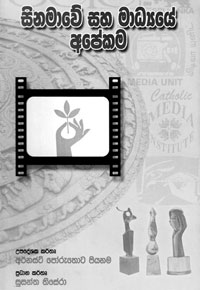
| A meaningful media resource book For over three decades, the OCIC (International Catholic Film Office) has done yeoman service for the Sri Lankan cinema. This service has now been documented in a 600-page Sinhala publication titled 'Cinamave Saha Maadyaye Ape Kama' - Sri Lankan Ethos of Cinema and Media. The book is edited by Susantha Tissera with OCIC's live-wire for many years, Father Ernest Porutota as Consultant Editor. For OCIC it has been hard work over the years in trying to contribute towards the progress of Sri Lankan cinema. One realises the value of its services now that OCIC activities have been documented. The activities are wide ranging from seminars and discussions in the early days to film annuals, publications on selected themes, special screenings of foreign films, workshops and awards presentations. Film annuals recording each year's Sinhala film releases began with the compilation of information on the 12 films shown in the first five years (1947-51). The subsequent publications continued to give valuable information on the films, providing the student of cinema a ready-reckoner of each year's releases.
'OCIC Salutations', as the awards presentations were referred to, became a much-awaited OCIC activity. This publication details the painstaking process adopted in the selections. OCIC Sri Lanka follows the guidelines set by OCIC International (incidentally, OCIC stands for 'Organization Catholique Internationale by Cinema') which include the award criteria, selection of the jury and the functions and responsibilities of the jury. The well thought-out citations reasoning out each award added a new dimension to the awards prompting other award-giving organizations to follow suit. The salutations began in 1972 and the publication lists out the details up to 2000. The book pays tribute to a host of enthusiasts who primarily helped the OCIC in its activities as well as those who have contributed towards uplifting Sri Lankan cinema. Records have been maintained systematically from the inception thereby making the task of picking up the relevant information easy. The list of participants at the inaugural meeting on September 4, 1972 at the Lincoln's Hall at the USIS, for example, brings back memories of the contribution made by stalwarts like Benedict Dodampegama and Ralex Ranasinghe. Glancing through the book, one realises how much the OCIC has been doing silently. The diary of events is interesting reading. To quote just one instance: 12-14 September 1974 - A seminar was held at the Hardy Institute, Ampara using a 16 mm projector (loaned by the Government Film Unit). The team went in a rickety old Ford car driven by Ashley Ratnavibhushana. Organiser was Fr. Frakcid Silva who was in charge of OCIC Ampara. The seminar was for the public. The service by the Catholic Media Unit has also been documented, providing an insight into the media courses held and research work done including publications. Contributions by several media personnel assessing Father Porutota's service and OCIC's role in the media scene too provide the researcher with valuable material. With the keen interest shown by the English readership on the local arts, this is the type of publication that must reach that segment as well. Just as much as Godage Publishers lent their support to put out this most exhaustive record, even an abridged version in English would be most welcome. A big 'thank you' to Father Porutota and Susantha Tissera for undertaking this venture to add to the publications on our media and the arts. |
|| Front
Page | News | Editorial | Columns | Sports | Plus | Financial
Times | International | Mirror | TV
Times | Funday
Times || |
| |
Copyright
2006 Wijeya
Newspapers Ltd.Colombo. Sri Lanka. |
